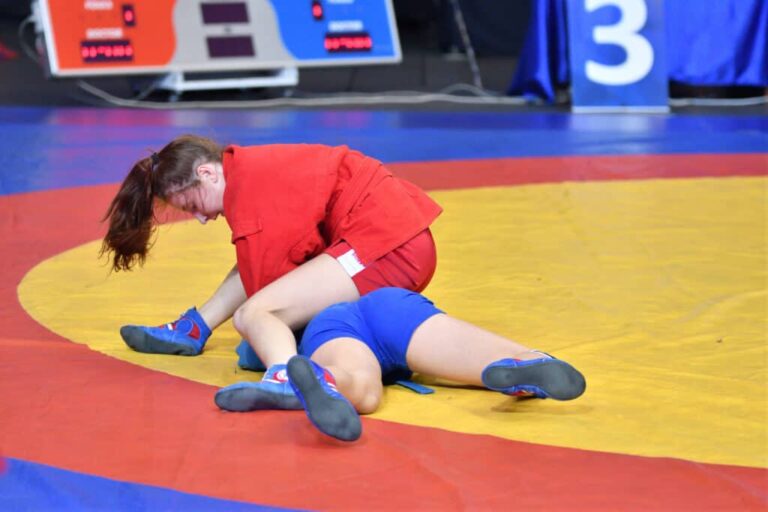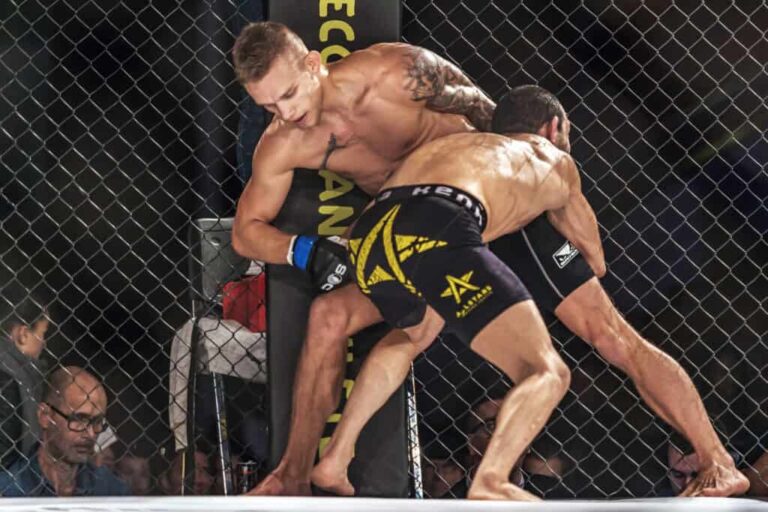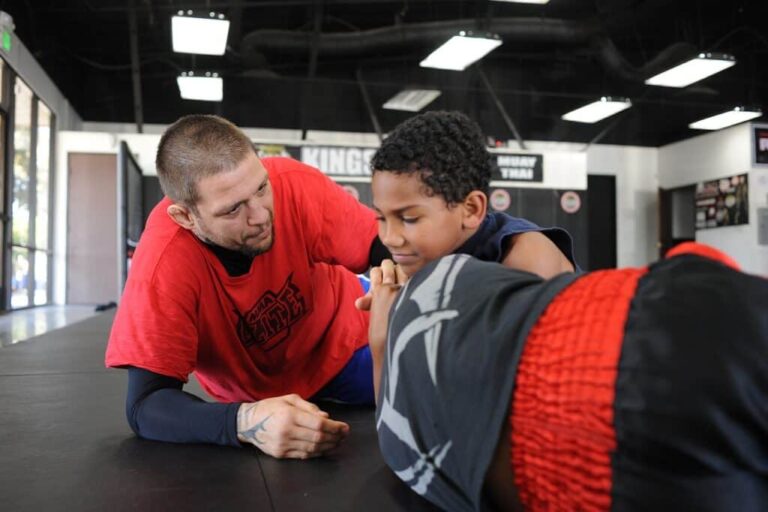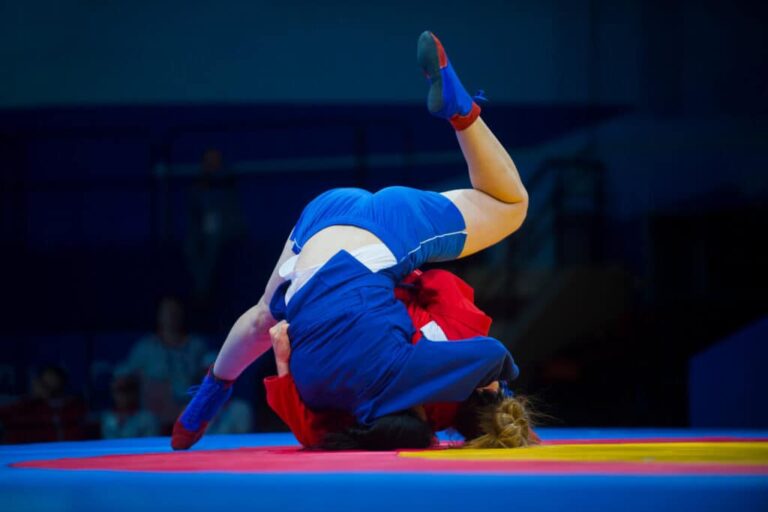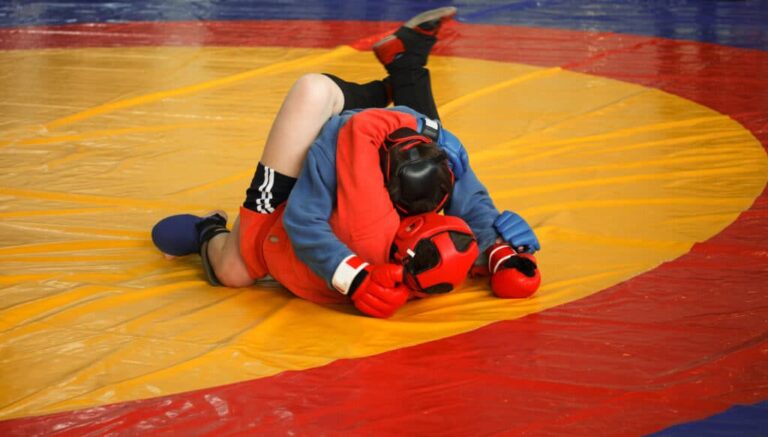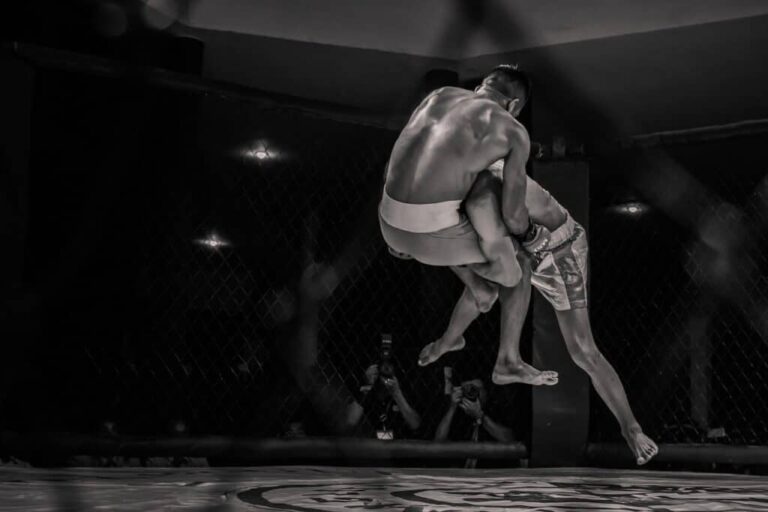Sambo Martial Art | The Ultimate Guide To Russian Sambo
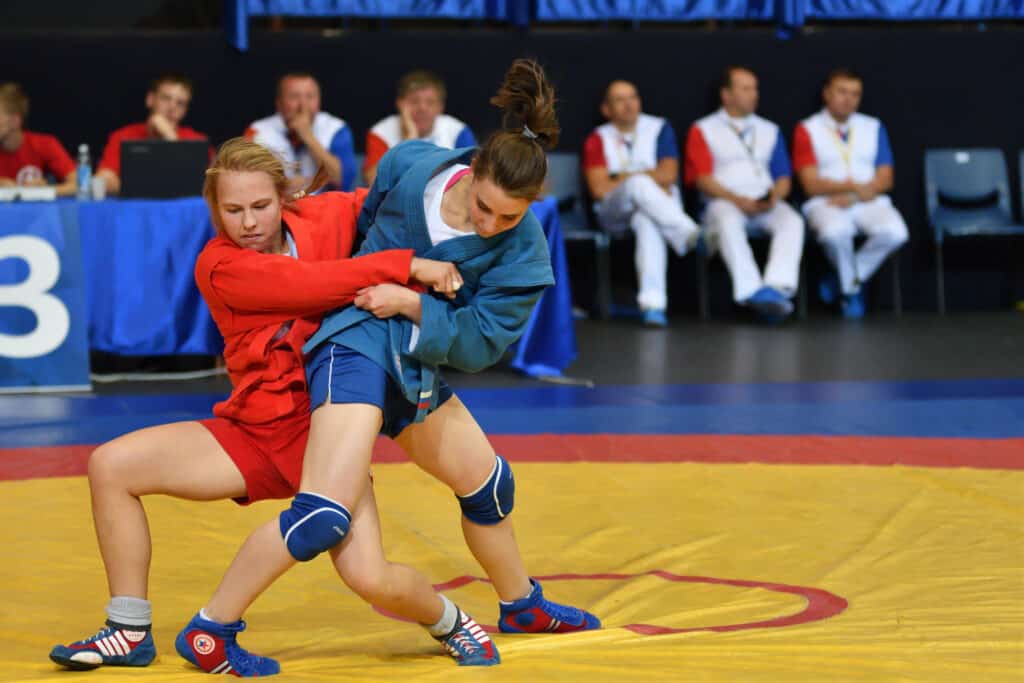
If you are new to grappling or martial arts you may be wondering what the martial art of sambo is all about. Essentially sambo is a modern Russian grappling and combat martial art that is used for sport, self-defense, and combat.
The martial art sambo is among the most modern wrestling styles, with a history dating to 1920’s Russian combat. It combines the stylings of Catch Wrestling, Jujitsu, Judo, and a variety of others to create a form of self-defense. Sambo is growing in popularity and quickly gaining recognition.
In the rest of this article, I’ll provide you with a complete guide to sambo as a martial art, including its history, styles, and basic guidelines. Read on to find out more about the fascinating fighting style that’s causing a buzz not only in Russia but all around the world.
Russian Sambo: History Of This Modern Martial Art
The martial of Sambo finds its roots in the Russian Tundra. This modern wrestling style dates back to the 1920s when individual members of the Soviet Army creatively sought to improve their hand-to-hand combat strategies.
As time has passed, sambo has found itself the subject of more than one newsworthy controversy, from its harsh fighting style to its very name.
The Founding Fathers of Sambo: Spiridonov vs. Oshchepkov
Much of what we know about Russian Sambo as a martial art can be traced back to two key influences: Victor Spiridonov and Vasili Oshchepkov. While these two men worked independently, their two similar styles eventually merged to form what we know today as modern sambo.
Others would later adapt and change these styles, but most people agree that sambo can be traced to their original work.
Victor Spiridonov
Victor Spiridonov was born in the Vyatta province and began his career fighting for the Tsarist army at seventeen. His courage and cleverness quickly helped him rise through the ranks and gain recognition as a renowned fighter and theorist.
Famously, Spiridonov studied fighting with the focus of a researcher, intensely developing techniques as one might hold as a scientific study.
During the darkness of the First World War, Spiridonov began work to develop early sambo techniques. Over the years, he wrote books on Sambo, continued to build its forms and strategies, and expanded its practices.
He also taught self-defense classes all over the country. Overall, he helped build Sambo’s reputation while at the same time never straying from the theory of fighting.
Though there is some minor controversy over who may be considered the true founding father of Sambo, Victor Spriridonov is widely regarded as its first creator. A statue recently erected in Russia credits him as being the “Father of Sambo Wrestling.”
Vasili Oshchepkov
Like Spiridonov, Oschepkov began his career as a fighter early. He worked on an international level, having been invited to join Japan’s leading Judo institute at nineteen. He continued to build his skills there, gaining worldwide recognition as the first Russian ever to receive a black belt in Judo.
These skills transferred to his work with Sambo. Judo and Catch wrestling methods heavily influenced Oschepkov’s original Sambo fighting style, creating a more strength-dependent than Spiridonov’s technically focused style. For years, Oschepkov’s methods were known in Russia as “free-style wrestling,” not to be confused with modern freestyle wrestling today.
Oschepkov’s Japanese history worked against him, and he later died in prison after being accused of being a spy. However, his reputation healed after his death, and all through Russia, one can regularly find monuments, orchestras, and fighting arenas dedicated to his memory.
Even after the death of its two most significant influences, sambo grew and changed, becoming more distinctively Russian as time passed.
As the sport was defined and perfected, it spread to surrounding countries. Though this change was a welcome one, it opened the sport up to controversies and various new problems.
Sambo Becomes A World Wide Martial Art Style
Because the sport pulled forms from an assortment of different wrestling cultures, Sambo quickly spread outside of the USSR borders. This amateur sport became popular in Japan, Bulgaria, Mongolia, and a wide range of other Eastern countries through the fifties.
Despite this fact, the sport remained on an amateur basis until 1966. The International Federation of Associated Wrestling Styles acknowledged Sambo as an official style, and the competitions snowballed from there. The first European Championship was held in 1972, quickly followed by the world championship in 1973.
In 1984, the International Amateur Sambo Wrestling Foundation (FIAS) was founded. Though the first meeting was held in Spain, representatives from over fifty countries were included, continuing to build Sambo’s reputation as a martial art and sport on a worldwide scale.
Through the efforts of FIAS, Sambo grew at an even more rapid rate, becoming acknowledged as an official style of several world games.
FIAS legitimized the form by adopting the Anti-Doping Codes and educating others about Sambo. Doing so helped clean up the reputation of the infamously brutal sport, but despite these steps, controversy continued.
Sambo and the Olympics
Sambo has had a fraught relationship with the Olympic games since the 1970s. Though it’s acknowledged in most World Games and was even a demonstration sport during the 1980 Olympics in Moscow, it is not currently an official Olympic sport.
The martial art’s history and reputation have worked against it, making the already slow process of becoming an Olympic sport even slower. The roots in combat and association with early world wars have marred the sport in the eyes of the committee, and its brutal combat style hasn’t significantly helped its brand.
Despite this fact, practitioners continue to advocate for the inclusion of this martial art in the Olympic games. In 2018, the International Olympic Committee announced that Sambo is still in consideration for eventual approval. From the very start of the battle, Vladimir Putin loudly joined those advocating for this sport.
Sambo Martial Arts Equipment and Gear
If you are interested in either practicing sambo or potentially holding a match, you’re in luck! The humble roots of this wrestling form create surprisingly minimal requirements, especially if you plan on participating in classic sambo.
Keep in mind, since the two most popular wrestling styles widely differ regarding what moves they allow, you’ll likely need more equipment and protective gear if you plan on practicing combat sambo.
Cleaning Supplies
If you plan to practice sambo, it’s essential to keep your area clean. This high-contact martial art is guaranteed to work up a sweat, and the time spent on the mat means that without proper care, your practice space could become a breeding ground for bacteria. Use a regular gym solution to wipe off the polyester mat cover before and after practices.
In addition, it’s important to shower and clean practice clothes after every match. This wrestling form requires constant close contact with an opponent, and the exchange of sweat, spit, and, in some cases, blood makes a post-practice shower a vital step to avoid infection and disease.
Gymnasium
One can practice sambo in almost any gym that sponsors wrestling. This being said the real challenge of sambo comes with finding a trainer who specializes in this sport.
Though sambo is growing in popularity, it’s still a bit of a niche sport with a somewhat rocky history. The exceptionally “lawless”-seeming elements of combat sambo mean that it’s often both a necessity and a challenge to find a well-trained coach.
If you’re struggling to find a coach and gym space, check out your individual country’s online Sambo database. There should be a page dedicated to training spaces and tournaments in your area.
Mats
The mat used for sambo is very similar to the mat for more traditional branches of wrestling. It’s traditionally made of three colors: blue, red, and yellow. The outside border of the mat is blue, with a target shape pattern of red and yellow in the center. A sambo match begins in the center of this target
The official sambo mat as selected by FIAS is the Foeldeak Sambo Mat, which consists of both the decorated cover and a lower foam portion. The cover is manufactured of an easy-to-clean polyester and is fixed to the lower mat portion through velcro.
The mat element itself is created from a combination of foam and felt designed to take the shock of a blow without slipping across the floor.
Sambo Uniforms
During a competition, Sambo practitioners wear a distinctive uniform of brightly colored red or blue. Traditionally called a kurta, the jacket is snugly fitted and closely resembles what’s worn during a Judo match.
The kurta is held in place through the use of a belt; however, unlike many other sports, this belt is not necessarily color-coded to indicate rank.
Along with the jacket, practitioners of this martial art style wear tightly fitted shorts of the same shade of either red or blue and regulation shoes.
Combat sambo also requires the use of protective gear. If you’re hoping to participate in combat sambo, you’ll be required to invest in shin guards and a sambo helmet that’s padded to protect against blows. Like many other high-combat sports, you’ll also need a mouthpiece and cup.
Sambo Martial Art Styles
Because sambo was created using a mix of classical wrestling styles and has a unique, distinctly Russian flair, the style is both similar and different from the others in surprising ways.
Though many of the general match rules are easily compared to judo, the combat style has built a reputation for being especially brutal in what it will allow.
Sambo comes in two different styles, classical sambo, frequently known as “sport sambo,” and the more brutal combat sambo. While both types of fighting use many of the same primary forms, combat sambo is considered far more brutal and allows striking.
Regardless of style, sambo is practiced on the same regulation wrestling mat.
Sport Sambo ( Purely Grappling Martial Art )
Classic sambo is closely related to judo and other wrestling styles and maintains a focus on self-defense. All general sport/classic sambo techniques fall into one of four categories: standup fighting, ground fighting, shifting from standing to the ground, or shifting from ground to standing.
Stand Up Grappling
Standup fighting methods include stances, throws, catches, and movements. While fighting in a standing position, sambo practitioners are best situated to focus on the movement, dodging, and throwing an opponent, all based on the distance between the two of them.
In classic sambo, there are five distances:
- Non-catching: the sambists focus on movement and have no intention of catching the opponent.
- Long-distance: distance is just close enough to catch the opponent by his sleeves.
- Middle distance: sambists are close enough to maintain a firm grip on the opponent’s jacket or body.
- Close distance: wrestlers are now close enough to easily grab the opponent.
- Quarter distance: wrestlers are close enough to use full-body weight against the opponent. At this distance, you may see the opponents throwing their bodies at one another.
Catches are maintained when an opponent has grabbed or swiped at another, and they’re the first step in preparing to throw an opponent. Catches are generally divided into main, reply, preparatory, or defensive catches.
Sambo Martial Art Throws and Takedowns
Throws are what frequently earn sambo the title of the most “powerful” martial arts sport. Once you’ve seen it in action, it’s easy to see why.
Opponents maintain a firm grip on the other using either arms or legs and use the opponent’s body weight against them, throwing them into the air or down onto the mat.
While throwing is not technically a requirement of sambo, most practitioners claim it can either make or break a match. The standard advice is to learn a small variety of throwing techniques but focus on the perfection of one signature throw.
Once this throw is selected, the player should attempt to constantly guide the opponent into a position vulnerable to that throw.
Ground Fighting
Ground fighting occurs at the start and finish of the match when sambists are either preparing for action or have just taken down the opponent. Sambo ground fighting methods focus mainly on holding an opponent in place and attempting to render him defenseless.
Ground fighting’s focus on holding means that many of the famous moves from this stance involve grabbing and twisting an opponent’s arms and legs.
Joint locks, for example, include applying force to an opponent’s joints to force a surrender. Famously, the armbar is a frequently used joint lock from the ground position.
Other standard joint locks include:
- Outer arm unscrewing
- Inner arm unscrewing
- Leg bar
- Bicep’s pinching
- Hip join lock
Joint locks can be incredibly painful and compelling. However, it’s crucial when practicing sport sambo to learn which holds and joint locks are considered too dangerous for use.
You can read a list of banned moves under the rules and regulations portion of this article.
Shifting From Standing To Ground
When shifting from standing to the ground, fighters utilize a variety of methods, including throws and joint locks. Most matches end with opponents on the ground, so this shift may occur as one opponent struggles to maintain the upper hand and pin the other.
Shifting From Ground to Standing
When shifting from the ground back to a standing position, sambists will utilize rising ups and throws, all in an attempt to plant feet firmly on the mat while disabling the opponent.
Combat Sambo: A More Comprehensive Martial Art Style
Combat sambo utilizes all the stylings of classical sambo with the addition of dangerous moves not allowed in a regular sports match. This style was created for use in aggressive military combat, and as a result, focuses more heavily on offensive actions than defensive ones.
While classic sambo exists with the primary goal of self-defense, combat sambo becomes a game of survival.
In addition to regular holds and throws, combat sambo utilized punches, chokes, and strikes that would be illegal in regulation sport sambo. While sport sambo most closely resembles judo or jujitsu, a combat sambo match may at first appear to be MMA to an untrained eye.
It’s important to note that when practicing combat sambo, sambists should always use safety gear and follow all agreed-upon rules to avoid long-lasting bodily injury.
Russian Sambo Rules
As in all martial arts, points are gained through a complicated system of touches and holds. There are, however, cases in which a player will automatically be declared winner in a match:
- A total throw: one player manages to throw a player with such strength that the attacker maintains a standing position while the victim is sent rolling across the mat.
- A painful hold: one player manages to pin the other in a painful enough joint lock that the other taps the mat in submission.
- Superiority: one player manages to gain twelve points over his opponent.
- Elimination
- Technical reasons
Elimination
For safety reasons, a player will be eliminated from a match if he regularly demonstrates a flagrant disregard for the rules of the game. This disregard can include repeated use of a prohibited hold or repeatedly ignoring warnings from the referee.
Prohibited holds include:
- Holding or throwing an opponent by his head with a painful grip
- Scratches or bites
- Applying force to an opponent’s fingers or toes
- Chokes with the intention of cutting off another’s air supply
- Painful holds in a standing position
A player may also be eliminated from a match for reasons related to his own safety. For example, if a doctor declares a player unfit, he will be barred from competing.
Similarly, if a player does not return from break within five minutes of the first call, his opponent will be declared the winner.
Though the sport has made a reputation for its brutal stylings, poor behavior is not acceptable in a sambo match. FIAS has worked to clean up the martial art’s reputation, and poor sportsmanship is now considered a disqualification-worthy offense.
This includes refusing to shake hands with an opponent or the use of foul language.
Technical Wins
When a match ends in a tie, referees and judges will use the events of the match to determine a winner. Victory may be declared for the player who demonstrates the widest variety of holds during the match.
If, for whatever reason, neither player stood out above the other in terms of technical points, the winner will be declared based on behavior. Whichever player received the last evaluation of warning during the match will be considered the winner.
Fighting Categories
Categories in a sambo match are divided into three defining features: gender, age, and weight. Gender is the first category, being divided into men and women.
The second category is age. In a sambo match, a contestant will fall either in the youth category, adult, or masters, which is the largest division, containing anyone above the age of thirty-six.
The final and most complicated division is weight. Competitors are given the choice to weigh in either the evening before a competition or that morning.
In contrast, some may attempt to cheat the system by fasting or denying themselves water before weighing in. It’s essential for safety reasons that all competitors be paired with appropriately sized opponents.
Notable Sambo Martial Artist
Though sambo has been a niche sport for much of its existence, the last ten years have seen a significant spike in interest. This growing fame is due mainly to a combination of outstanding fighters and advocates of the sport who have worked to bring light and interest to this fascinating martial art.
Rais Rahmatulin
One of the first in a long line of fighters from the USSR, Rais is considered one of the honored masters of the sport. He carries seven Sambo world championship titles, five World Cup wins, and received a medal of the Order of Merit for the Motherland of II Degree.
Rais is considered an unusual fighter, largely due to the amount of time he spends on the mat. While other champions focus on the impressive throws of the sport, Rais has mastered holds, making the knee lever his signature move.
While advocating for this sport, Rais has focused on the level of personal development and discipline he has learned through his time practicing sambo. He is quoted as saying:
“If I didn’t do sambo I’d never be as sure of myself as I am. Sport makes you understand that you can handle any situation. How to become a champion? By combining two things: dedication and hard work. It is the only way to achieve results.”
Viktor Savinov
Viktor Savinov is a six-time world champion and six-time European champion of the sport. Though he was born in the USSR, he has been deemed a master of the sport in Ukraine. In addition to being an elite fighter, Viktor Savinov is also a police chief who teaches physical training at the Kharkov National University of Internal Affairs.
During his time on the mat, Viktor Savinov took special pride not only in practicing the sport but in successfully defending his titles. He said, “I already have more than 80 medals and I can tell you a story about each of them and I remember where I won it. I think that when I finish fighting I’ll write a book about it.“
Though his time on the mat is completed, Savinov continues to advocate for the sport as a member of the executive committee and chairman of FIAS.
Irena Viktorovna Rodina
One of the most notable female practitioners of sambo is doubtlessly Irena Viktorova Rodina, born in Russia. She was one of the first women to actively participate in this martial art, and during her career worked to become an eleven-time world champion and gain an array of other titles.
Irena Vikorovna Rodina took a major risk in becoming an ultimate fighter, and her path was not an easy one. When she became fascinated with the sport of Judo, her parents disapproved to the point that she had to sacrifice their relationship to continue her career.
To Irena, this perseverance in the face of sure defeat encompasses what makes fighting so special. She says, “Even if you are obviously losing you should fight to the end, and even if you obviously surpass your opponent, you should always stay alert.” Irena continues to actively train, fight, and win matches to this day.
Svetlana Alekseevna Galant
Another iconic woman in the world of sambo is Svetlana Alekseevna Galant. Born in Moldova, Svetlana Galant is a seven-time world champion, eight-time winner of the World Cup, and recurring “Sportswoman of the Year.” She has also received the medal of the Ministry of Defense of the Russian Federation “For Military Valor” of II Class.
Galant trained professionally at the Far Eastern State Academy of Physical of Physical Culture and Sports and graduated from the academy with honors. Of all Sambo athletes from her part of the world, Galant has achieved the highest honors and most prestigious awards.
Today, she trains herself, holds free classes, and loudly advocates for the technique of the sport. She works to continue developing this relatively new sport, perfecting and learning as she goes.
Vladimir Putin
Today, one of the most famous and outspoken advocates of the sport is none other than Vladamir Putin. The leader has brought wide media attention to this martial art through his practice, earning the title of honorable master of sport in Russia and a black belt in both sambo and Judo.
In particular, Putin has focused his attention on working to earn Sambo its place in the Olympics. He has held countless press conferences describing how this sport could add to the cultural diversity of the Olympics and critiquing the imbalance of sports currently included.
“Exclusion from the Olympic games of traditional kinds of sports that initially formed the basis and were a part of the Olympic program far back as in ancient Greece is unfair,” he stated at a 2013 press conference.
In support of his point, he listed countries that continue to create tournaments for this traditional Russian sport, even going so far as to invite the leader himself.
Vladimir Putin continues to train today, building upon his skills and bringing further attention to what has become known as the sport of his nation.
Sambo In Mixed Martial Arts
Since combat sambo is so similar to MMA you might wonder how Sambo fighters have done in MMA. Well a few good examples of how effective sambo can be in MMA is Fedor Emelianenko and Khabib Nurmagomedov.
Both of these fighters come from a Sambo background and both of them are considered to be the Greatest Of All Time.
I would personally consider these two to be up there as the greatest fighters of all time. They were certainly both dominant in their careers and have proven that Sambo can be a great base for any MMA fighter.
Naming Controversy Of Russian Sambo
The name “Sambo ” is an acronym derived from the original Russian title, “samozashchita bez oruzhiya.” Fashioned on Spiridonov’s original style, this translates to “self-defense without weapons.”
Unfortunately, this acronym has faced some controversy. As the sport gained traction worldwide, Swedish practitioners pointed out that in their culture, the word “sambo” is a slur referring to two unmarried partners living together.
This created problems as practitioners struggled to build the sport’s reputation without creating offense along the way.For this reason, many have chosen to refer to the sport as “sombo” instead, keeping the original pronunciation but changing the spelling to avoid confusion.
The officially recognized English spelling of the sport, as declared by USA wrestling, is sombo. However, the spelling, pronunciation, and grammar of the word change by nation.
Conclusion
Sambo is a relatively young addition to the ancient world of martial arts and wrestling, and as a result, it exists in a stage of constant growth and development. So practitioners of the sport get to witness this history unfold in real-time.
Learning more about this culturally relevant sport is guaranteed to pay off whether or not one participates. Sambo can be a great base for MMA or perhaps other grappling sports. In addition, Sambo also has a lot to offer people who want to learn self-defense.
